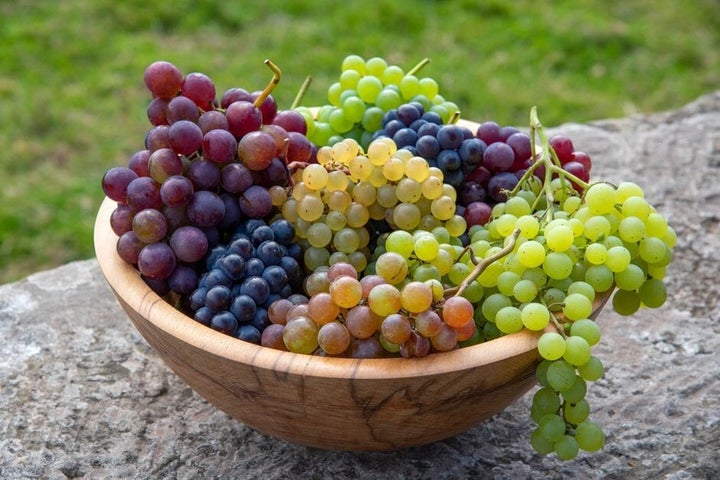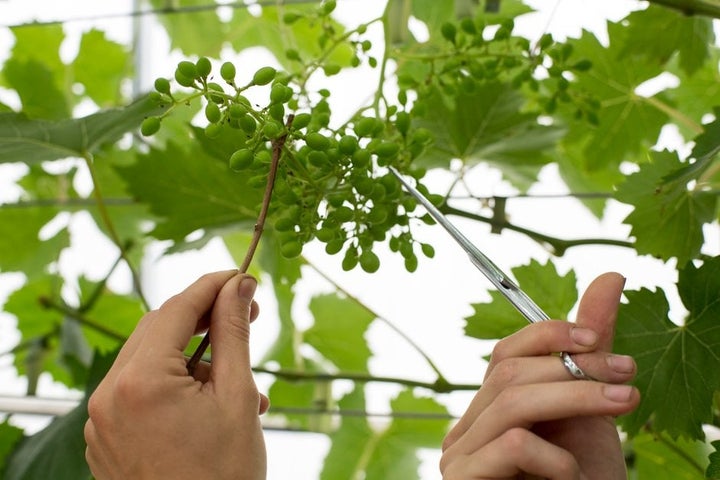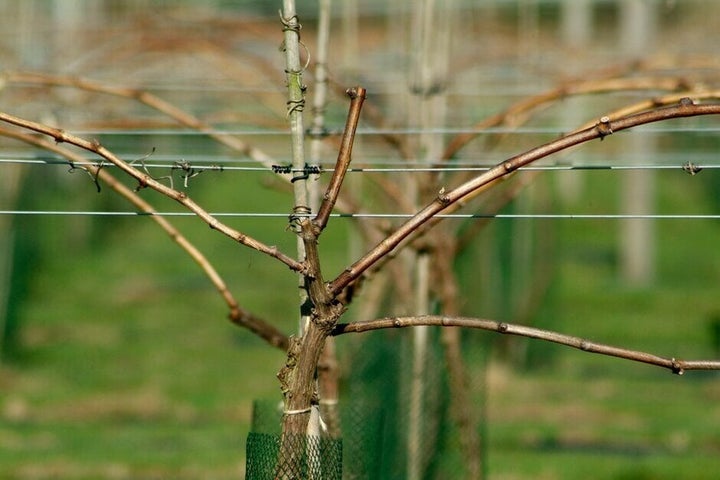Getting Started
Grapes are becoming much more widely grown in the UK, with vineyards appearing on sunny hillsides in warmer regions, producing many award-winning wines. Grapevines(Vitis vinifera) also make an attractive feature in gardens, but for a successful crop of ripe grapes, they need a warm, sheltered, sunny location or the protection of a greenhouse.

Grapevines are fast-growing climbing plants that need plenty of space. They will happily scramble over pergolas and arches, or can be trained along horizontal wires attached to sunny walls, fences, sturdy posts or the internal framework of a greenhouse. To get the best crop, vines need regular attention throughout the growing season, including careful pruning, training and . Grapes ripen between August and October, depending on the variety and growing conditions.
Jobs to do now
Plant vines
Prune
Month by Month
Plant Out
Harvest
Choosing What To Grow

There are two main types of grapes – dessert grapes (for eating) and wine grapes – although some varieties may be suitable for both uses.
- Dessert grapes, also known as table grapes,need warmer temperatures to ripen well, so usually need to be grown in a greenhouse in the UK. In very warm sites, especially in southern England, selected varieties may ripen outdoors too
- Wine grapes can be grown outdoors in milder regions or in a greenhouse. The grapes aren’t usually too good to eat – they tend to be small, often with lots of seeds and a tough skin. Winemaking can be fun, though producing quality results requires skill and experience
Within the two categories there are many varieties, offering white, red or black fruits, seeded or seedless, with different flavours, levels of sweetness, ripening times, hardiness and resistance to disease.
Take care to select a variety to suit your local climate and growing conditions. Your choice of variety will be greatly influenced by where you intend to grow the vine – in a greenhouse or outisde. Look in particular for varieties with an RHS Award of Garden Merit (AGM), which shows they performed well in trials – see our list of AGM fruit and veg (135kB pdf) and our Recommended Varieties below. You can also see many fruits growing in the RHS gardens, so do visit to see how they’re grown, compare different varieties and pick up useful tips.
Good to know
The fruits of both edible and ornamental grapevines are harmful to dogs if eaten.
What and where to buy
Grapevines are available in garden centres and from many online gardening retailers. Specialist fruit suppliers offer the widest choice and will be able to advise on suitable varieties and rootstocks for your needs. Grapevines are often sold as grafted plants, but rooted are also available. If you intend to plant a large number of vines, to start a small vineyard for example, buy vines grafted on a rootstock best suited to your soil type. A selection of suitable rootstocks for different soil types are:
- Deep, fertile, non-chalky soils – 125AA, 5C and SO4
- Deep, fertile, chalky soils – 5BB, 125AA, 5C and SO4
- Shallow, poor, stony, dry soils – 5BB and 125AA
- Heavy clay soils – 5BB, 125AA and SO4
- Heavy, chalky clays or on chalk – SO4
Vines are sold as young plants, usually 30–60cm (1–2ft) tall, either container-grown or . Potted plants are available for most of the year, while bare-root vines are only available during the season, from November to March, mainly from mail-order suppliers. Bare-root plants are usually cheaper than potted plants but need to be planted immediately.
Recommended Varieties

'Sovereign Coronation' AGM
A seedless dessert grape. Dark blue-purple fruits have a sweet musky flavour.

'Reliance' AGM
A sweet, seedless, red, dessert grape. Fruits early, so copes in cooler sites.

‘Schuyler’ AGM
A dessert and wine grape. Sweet, seedless, blue-black grapes. Also sold as 'Boskoop Glory'.
Planting
Vines are best planted while , between November and early March. Early spring is a good time to plant outdoors to avoid winter damage to vulnerable young plants. Choose a warm, sheltered, sunny site, at the base of a support such as a south-facing wall. Put a good support system in place before planting. Avoid locations prone to late frosts, which can damage new shoots in spring. Grapevines prefer a soil pH of 6.5 to 7, but grow well in a range of soils, provided the site is free-draining and never becomes .
On decent soil, no additional preparation is generally needed before planting. However, if your soil is poor or you are planting near a wall, dig a bucketful of organic matter, such as garden compost, into the soil you remove from your planting hole and use this to backfill after planting. This minimises soil disturbance and helps your vine get off to a strong start.
Container-grown grapevines should be planted at the same depth they were in the pot. vines should be positioned so the first roots are only just below the soil surface. If the plant is grafted, make sure the graft point on the stem is above the soil surface. When planting against a wall or fence, position the vine at least 20cm (8in) from its base so there’s space for the roots to spread out. If planting more than one vine, set them 1.2-1.5m (4-5ft) apart. If you have room for a mini-vineyard, ideally on a south-facing slope, space the rows 1.5–1.8m (5–6ft) apart, running north to south.
Planting in a greenhouse
If you want to grow a grapevine under glass, it’s best to plant it just outside the greenhouse with its trunk and stems trained inside through a gap near ground level. Vines grown in this way rarely need extra watering. They can also be planted inside, directly into a greenhouse border or in a large container (see below).
When planting inside, the best position is at the far end, so the stems can be trained along the side of the greenhouse, parallel to the roof ridge, running towards the door. One vine is plenty for a small greenhouse – if planting more in a larger greenhouse, space them at least 1m (3½ft) apart.
Planting in a container
When space is tight, you can plant a grapevine in a large container and train it as a standard, shaped like a small tree with one main stem and a rounded head – see ourguide to training grapes as a standard for more details. Choose a pot at least 30cm (12in) wide and deep, and use soil-based peat-free . Position the pot in your warmest, sunniest spot outdoors or keep it in a greenhouse or conservatory. To fruit successfully, grapevines need a cool period. If your greenhouse or conservatory is heated, place the container outside for four to six weeks during winter.
Plant Care
To fruit well, and for the crop to ripen successfully, grapevines need regular attention throughout the growing season. Information on the different care tasks is shown below and in our guides to indoor and outdoor cultivation of grapes.
Watering
Water newly planted grapevines during dry spells in their first to help them settle in. Once established, vines grown with their roots outside shouldn't need any additional watering. Although vines trained against walls or fences may require some additional watering if they’re in a rain-shadow – where the wall or fence reduces the amount of rainfall they receive. Grapevines planted inside a greenhouse or in containers require regular watering during the growing season.
Mulching
With outdoor vines, apply a of organic matter, such as garden compost, in late winter or early spring. Aim to apply a layer 5–7.5cm (2–3in) deep. will improve your soil, help to retain moisture and suppress weeds. With a greenhouse vine, mulch the rooting area just before growth starts in spring. Mulch should not touch the stem, as this may lead to rotting.
Feeding
Grapevines growing in regularly mulched soil shouldn't need any additional feeding. However, if harvests are particularly poor, or your plant is showing signs of nutrient deficiency, apply a granular fertiliser to the soil in early spring. Use our page on nutrient deficiencies to work out what is lacking and apply the recommended feed, following instructions on the packet.
With greenhouse vines and those in containers, start feeding a month after growth starts in spring, using a high-potassium liquid feed every two to three weeks. If growth is poor, use a high-nitrogen or balanced liquid feed. Stop feeding when the grapes start to ripen and colour up, as extra feeding at this time may spoil their flavour.
Removing flowers and fruit
With newly planted grapevines, for the first two years after planting, remove all the flowers so the plant’s energy goes into getting well established. Then, in the third year, allow only three bunches of grapes to grow, and in the fourth year allow about five – or slightly more if the plant is growing well. After that, the vine should be well established and can crop fully.
You can improve the size, sweetness and quality of grapes by reducing the number of bunches on each stem, and even the number of grapes per bunch. The ideal amount of bunches per plant depends on the age of the vine and the training system you use, see Pruning and training below. Reducing the number of grapes in a bunch encourages even ripening and improves air circulation, which reduces fungal diseases. But it’s a fiddly job, so is usually only worth doing on dessert greenhouse vines. Use vine scissors, which have long, narrow blades, or nail scissors, and carefully snip off about one in three grapes per bunch. Afterwards, check the bunches two or three times a week and remove any grapes that are diseased or damaged.

Greenhouse grapevine care
Ventilation and temperature
Grapevines like well-ventilated, warm, dry conditions, to deter fungal diseases and improve pollination. So keep the vents open in summer and autumn, especially around flowering and fruiting time.
In September, gradually remove the leaves to expose the branches to sunlight and improve air circulation. Some varieties, such as ‘Muscat of Alexandria’, benefit from extra heat, so for these place a small fan heater in the greenhouse in spring (to aid growth) and in autumn (to aid fruit ripening). In winter, don’t heat the greenhouse and ventilate it freely in still, cold, dry weather until early spring, as vines need a period of chilling to initiate flowering.
Improving pollination
Almost all grape varieties are self-fertile and mostly pollinated by wind, though insects may also contribute to pollen transfer. Greenhouse vines often benefit from some additional help with pollination. During flowering, at about midday on a sunny day when the atmosphere is dry and the greenhouse is well-ventilated, either shake the stems or stroke a cupped hand over each bunch of flowers, to transfer pollen between them. The latter is a more reliable method for early season Muscat-type grapes, where pollination can be temperamental.
Removing tendrils
Consider removing the tendrils of indoor vines as soon as they appear, as they tend to get tangled up with the fruits and they help shoots to scramble off in wayward directions, making pruning and training more fiddly.
Propagating
Grapevines can be grown from taken in late autumn or winter. Softwood and can also be taken from late spring to mid-summer. Commercially, grapevines are often propagated by whip-and-tongue on a rootstock.
While it is also possible to grow grapevines from seeds (pips), it’s a slow process and the resulting plant is likely to produce lower quality fruit than its parents. There are also risks associated with growing from the seed of supermarket-bought fruits, so this should be avoided.
Pruning And Training

Grapevines are vigorous plants and if left to their own devices will soon outgrow their space, producing lots of lush leafy growth and tangled shoots. So to keep them in check and maximise fruiting, they should be pruned every winter and trained onto supports – usually horizontal wires attached to a sunny wall or fence or to the inside of a greenhouse. They can also be grown along post-and-wire supports in favourable locations.
The main pruning should be done in early winter, while vines are , then regular maintenance (pinching out unwanted shoots, removing leaves shading the fruits, and ) should be carried out throughout the to keep them in good shape, healthy and fruiting well.
The two main types of grapevine training and pruning are the rod and spur ( ) method and the Guyot method. Rod and spur pruning is a very versatile method of training, suitable for grapevines in gardens and greenhouses. The Guyot method is used in vineyards, gardens and allotments, with the grapevines grown in rows along post-and-wire supports. For full details of both training methods, see our guides below. A grapevine grown in a container is kept compact by training it as a standard.

If you don’t have the time or capacity for regular pruning and training, and have plenty of space, you can grow a grapevine informally, as an ornamental climber, over a large pergola, archway or sunny wall. It may still produce some fruit, but less successfully than a well-pruned vine. Grapevines are useful for providing shade in summer and attractive leaf colour in autumn.
Harvesting
Grapes ripen from late summer to mid-autumn, depending on the variety and weather conditions. Dessert grapes are ready for picking when they feel soft and taste sugary. The skin of white grapes often changes from deep green to translucent yellow and becomes much thinner. The best way to tell when grapes are ripe is by tasting them – harvest them only when they’re at their sweetest, as they won’t ripen any further once picked. Cut the whole bunch with the stalk still attached.
Although wine grapes can be eaten fresh, they tend to be small, fairly acidic and have thicker skins, so they’re better pulped and made into wine.
You can use young vine leaves in cooking, to make stuffed vine leaves, or dolmadas, and other similar dishes.
Problem Solving
Grapevines need warm, sunny conditions to crop well in the UK, and late frosts can damage new shoots, which can reduce fruiting. Vines are prone to several fungal diseases that can affect their vigour and cropping – see our guide to grapevine diseases below.
Birds can damage and eat crops. If you are losing too many grapes to birds, protect your crop by covering vines with plastic-free or reused netting. Raise the netting above the fruits using bamboo canes or wood, such as hazel or chestnut poles. Ensure the netting is taut and fastened securely so birds and other wildlife don’t get entangled in it. Alternatively, if you only want one or two grapevines, grow them inside a fruit cage.
If your dessert grapes are disappointingly small and full of pips, try reducing the number of bunches next season – this often results in larger, better-quality fruit. See the Removing flowers and fruit section above.
Common Problems

Grape shanking
Grape vines grown under glass can suffer from shanking, which means that individual berries within a bunch do not colour up properly, and eventually s...

Nutrient deficiencies
Changes in leaf colour are often a sign that plants aren’t getting the nutrients they need. Pale, yellow or reddish coloured leaves are common, but st...










